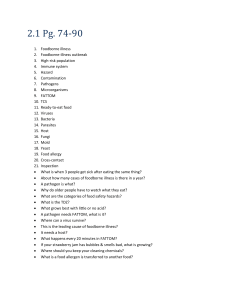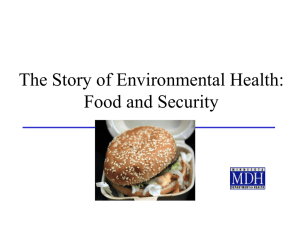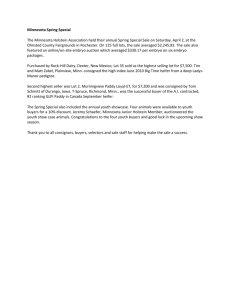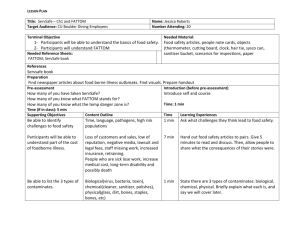Food Safety Food Security and Minnesota Department of Health
advertisement
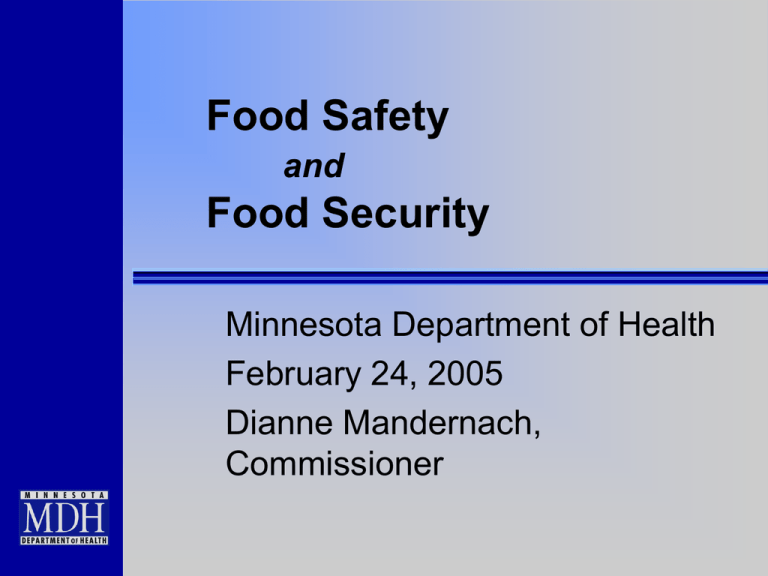
Food Safety and Food Security Minnesota Department of Health February 24, 2005 Dianne Mandernach, Commissioner Is it safe? How do you know the food you just ate was safe? How do you know the water in your glass is safe to drink? We all take our food safety for granted. What the Food Safety system looks like from Farm to Table Farm Processor Distribution Center Retail Restaurant / Home Minnesota Food Safety network (Poultry) PCA APHIS Farm Feed Proc MBAH Consumer Retail Trans “Food Safety” vs. “Food Security” a question of terminology “food safety” is part of our public health vocabulary we all have a good idea what it means it covers a range of activities Food Safety includes…. Preventing foodborne illness – protecting crops and food animals from contaminants and pathogens – Preventing contamination/adulteration during processing and distribution – regulating and inspecting food establishments (enforcing food codes) – educating about food handling at hygiene (in the home and elsewhere) Food Safety includes…. Identifying & responding to outbreaks – effective surveillance for foodborne illness – using genetic fingerprinting, other lab techniques to identify or rule out outbreaks – sharing of information through vehicles like PulseNet – identifying and addressing the sources of foodborne illness (outbreak investigation – closing the loop) Food Safety includes…. Addressing emerging foodborne disease threats (e.g. – BSE in cattle) In short, food safety is…. everything we do to protect the food supply a basic function of public health On the other hand…. “Food Security” is – a relatively new term – not always used consistently – not clearly distinguished from “food safety” A suggested definition…. “Food Security” – is a part of the broader food safety picture – deals primarily with intentional efforts to harm or compromise our food supply Food Safety vs. Food Security Food Safety – the big picture Food Safety vs. Food Security Food Safety – the big picture Food Security – a new piece of the puzzle But is it so new? We didn’t think much about food security before 9/11 In fact, our food supply has always been vulnerable to mischief First bioterrorism incident in modern era involved foodborne disease The Rajneeshee cult Oregon – mid-1980s Spiked restaurant salad bars with salmonella Objective was to influence local election Had no effect on election – but caused widespread disease We are vulnerable An attack on our food supply could take many forms – targeting of crops and food animals – using agents like soy bean rust or footand-mouth (severe economic impact) – contamination of food with pathogens or toxic materials – anywhere between the farm and the table Human health and economic impacts Potential for widespread illnessunprecedented numbers • 76 million cases of “natural” food borne illness in US each year • 325,000 hospitalized • 5,000 died (CDC) Costs would be measured in billions of $ – $6.9 billion/year for 5 pathogens (USDA/ERS 2000) – Mars candy hoax cost $4.5 million loss What are we doing? A look at some state/federal initiatives: – Government Coordinating Council – ASTHO; Food Safety and Security Taskforce – Other states – Multistate Partnership for Agrosecurity – Minnesota Government Coordinating Council (GCC) Government Food and Agriculture Sector GCC works with Private Sector entities Part of National Infrastructure Protection Plan (NIPP) of Homeland Security • Identify critical infrastructure, assess vulnerabilities, prioritize high risk assets, implement protective measures, measure effectiveness Food and Agriculture Sector -- Homeland Security Information Network (HSIN-F&A)\ HSIN is designed to – Improve and streamline communications and information sharing – Provide access to resources – Enhance collaboration – Provide incident and infrastructure monitoring capabilities • Pilot testing scheduled Kentucky DPH’s food security information sheet Distributed to all food establishments holding a food permit Information, tips for increasing overall food security and managers’ and employees FS awareness • Lock doors to prevent unauthorized entry • Restrict unauthorized personnel in food production areas (kitchen) The sheet also provided space for local emergency phone numbers to be written North Carolina NC DHHS participates in NC Food Security and Safety Coalition – Coalition has conducted series of tabletop exercises on food security issues –“Dark Pantry” Dark Pantry Designed to: – Exercise state, federal, local agencies’ and industry’s • Response to • Crisis management of • Consequence mitigation of – A lethal contamination of the state’s food supply Dark Pantry--Food Security Problems – Vulnerabilities within the food chain not fully understood – Known vulnerabilities not tied to current threat reduction efforts – Threat reduction effort not tied to National Threat Alert Schemes – Intelligence assessment and industry threat detection not coordinated or integrated – Response and mitigation plans not coordinated with vulnerability or threat/intelligence assessments Multi-State Partnership for Agriculture Security Collaboration of several state departments of agriculture IA, MN, WI, SD, MI, KS, NE, IL Received $2 million for joint projects – Risk communication – Response plan template and assessment – Assessment of animal and plant disease surveillance What is Minnesota doing? Multifaceted approach to food safety, food security – MN Dept. of Agriculture – MN Dept. of Health • Food-borne illness surveillance – Epidemiologists+Public Health Lab+clinical labs • EH Food Service regulation/education – Board of Animal Health – University of Minnesota – Homeland Security and Emergency Management (HSEM) Minnesota Dept. of Agriculture Issued recommendations on preventing terrorist activities at food and dairy facilities Providing guidelines for facilities and producers to do advance planning for emergency management. Offering security tips for chemical storage facilities Offering security tips for feed manufacturers. Minn. Dept. of Agriculture Enhancing GIS capacity Agricultural Commodity Vulnerability Assessment – With Univ. of Minn. – Use assessment of fluid milk supply as template for others Education/Outreach – With local Emergency Management Directors – Seminar w/ UoM on food security held in 5 major cities Minn. Dept. of Health MDH-EH efforts have been mainly to: – 1. Raise awareness among all players, public and private sector – 2. Develop response and recovery plans as a food annex to the MDH emergency response plan – 3. Build connections between different parts of the system MDH advice to food service – Maintain cleanliness and sanitation in establishments; – Restrict access – Monitor work areas; – Encourage customers to report suspicious behavior; – Remove clutter and unwanted chemicals; – Ensure that salad bars are supervised; and – Inspect incoming orders, maintain tracking of ingredients and outgoing food. Minn. Dept. of Health – Held workshop, “Identifying the gaps in Food Emergency Response Plans” in May 2004 – Conference for Food Protection publicprivate workgroup – Increased overall communication capabilities: GovDocs What if prevention fails? Maintain and strengthen surveillance system – MN enjoys strong interaction between the state public health lab, state epis, all clincial labs and MDA • Proves itself again and again: – Detected E. Coli O157 in frozen steaks sold door to door in several midwestern states What are we learning? What do we need to do? Good food safety maximizes food security Prevention important, but need adequate response to limit impacts. Work toward national real time capabilities. State departments of Agriculture are not getting adequate preparedness dollars – Need to find way to get $ from USDA and FDA to state and local levels What else are we learning? What else do we need to do? Communication is key! – Keep trying to cut across “silos” and build connections among all players, especially local entities Remember: All disasters are local!
